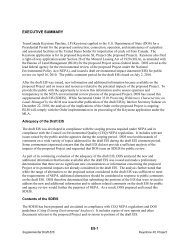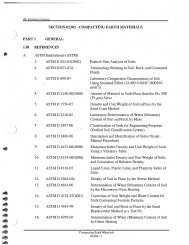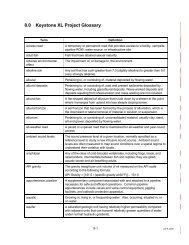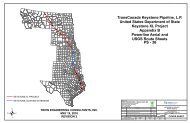2.1 Overview of the Proposed Project - Keystone XL pipeline - US ...
2.1 Overview of the Proposed Project - Keystone XL pipeline - US ...
2.1 Overview of the Proposed Project - Keystone XL pipeline - US ...
You also want an ePaper? Increase the reach of your titles
YUMPU automatically turns print PDFs into web optimized ePapers that Google loves.
Draft Supplemental Environmental Impact Statement<strong>Keystone</strong> <strong>XL</strong> <strong>Project</strong>powered rectifier and an anode, or array <strong>of</strong> anodes, buried in <strong>the</strong> ground (<strong>the</strong> anode groundbed).A rectifier is an electrical device that converts AC, which periodically reverses direction, to DC,which flows in only one direction. The process is known as rectification. Rectifiers are <strong>of</strong>tenfound serving as components <strong>of</strong> DC power supplies and high-voltage DC power transmissionsystems. The primary impressed current CP systems would be rectifiers coupled to semi-deepvertical anode beds at each pump station, as well as rectifiers coupled to deep-well anode beds atselected IMLV sites. During operation, <strong>the</strong> CP system would be monitored and remediationperformed to prolong <strong>the</strong> anode bed and systems. The semi-deep anode beds would be 12-inchdiametervertical holes spaced 15 feet apart with a bottom hole depth <strong>of</strong> approximately 45 feet.The deep-well anode bed would be a single 12-inch-diameter vertical hole with a bottom holedepth <strong>of</strong> approximately 300 feet.<strong>2.1</strong>.7.2 Pipeline Construction Procedures<strong>Keystone</strong> is a limited partnership, organized under <strong>the</strong> laws <strong>of</strong> <strong>the</strong> State <strong>of</strong> Delaware. <strong>Keystone</strong> is<strong>the</strong> entity that would be responsible for construction <strong>of</strong> <strong>the</strong> <strong>pipeline</strong> if approved. To construct,operate, and maintain <strong>the</strong> proposed <strong>Project</strong>, <strong>Keystone</strong> would need <strong>the</strong> rights to easements along<strong>the</strong> entire proposed route. <strong>Keystone</strong> is responsible for acquiring easement rights from landownersalong <strong>the</strong> route in each state. Easement agreements would list <strong>the</strong> conditions that both <strong>the</strong>landowner and <strong>Keystone</strong> agree to, including financial compensation to <strong>the</strong> landowners in returnfor granting easements. Compensation would also be made for loss <strong>of</strong> use during construction,crop loss, loss <strong>of</strong> non-renewable or o<strong>the</strong>r resources, and restoration <strong>of</strong> any unavoidable damageto personal property during construction. The Department expects <strong>Keystone</strong> to negotiate fairly,honestly, and respectfully with landowners when <strong>the</strong>y negotiate an easement. However, thosenegotiations and final agreements are private business concerns between <strong>the</strong> landowners and<strong>Keystone</strong>.If <strong>Keystone</strong> obtains all necessary permits and approvals and an easement negotiation cannot becompleted in a manner suitable to both parties, <strong>Keystone</strong> may attempt to use state eminentdomain laws to obtain easements needed for <strong>pipeline</strong> construction, maintenance, and operation.State laws dictate under what circumstances eminent domain may be used and define <strong>the</strong> eminentdomain process within <strong>the</strong> state. The level <strong>of</strong> compensation would be determined according toapplicable state law. State or local trespass and access laws are applicable along <strong>the</strong> entire routeand <strong>the</strong>refore along each easement negotiated by <strong>Keystone</strong> and <strong>the</strong> landowner or obtained by<strong>Keystone</strong> through <strong>the</strong> eminent domain process. The Department has no legal authority overnegotiating easement agreements and has no legal status to enforce <strong>the</strong> conditions <strong>of</strong> an easementagreement. A landowner who considers <strong>Keystone</strong> to be out <strong>of</strong> compliance with an easementagreement would need to discuss <strong>the</strong> matter with <strong>Keystone</strong> or local law enforcement <strong>of</strong>ficials, orinitiate legal consultation.Once engineering surveys <strong>of</strong> <strong>the</strong> ROW centerline and additional TWAs have been finalized, and<strong>the</strong> acquisition <strong>of</strong> ROW easements and any necessary acquisitions <strong>of</strong> property-in-fee have beencompleted, construction would begin. As proposed, <strong>the</strong> <strong>pipeline</strong> would be constructed in 10spreads (or sequences) <strong>of</strong> approximately 45 to 120 miles long (see Table <strong>2.1</strong>-13). Final spreadconfigurations and <strong>the</strong> final construction schedule may result in <strong>the</strong> use <strong>of</strong> additional spreads orfewer shorter or longer spreads. Figure <strong>2.1</strong>.7-1 depicts <strong>the</strong> approximate location <strong>of</strong> each spread.<strong>Project</strong> Description <strong>2.1</strong>-38 March 2013











